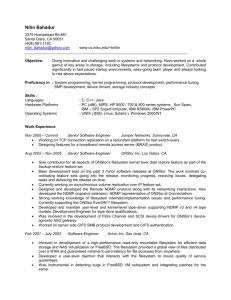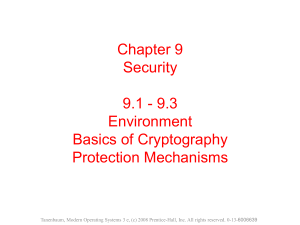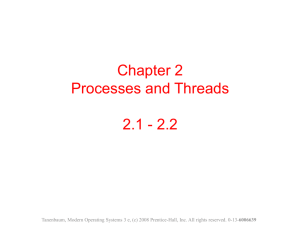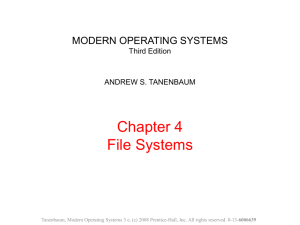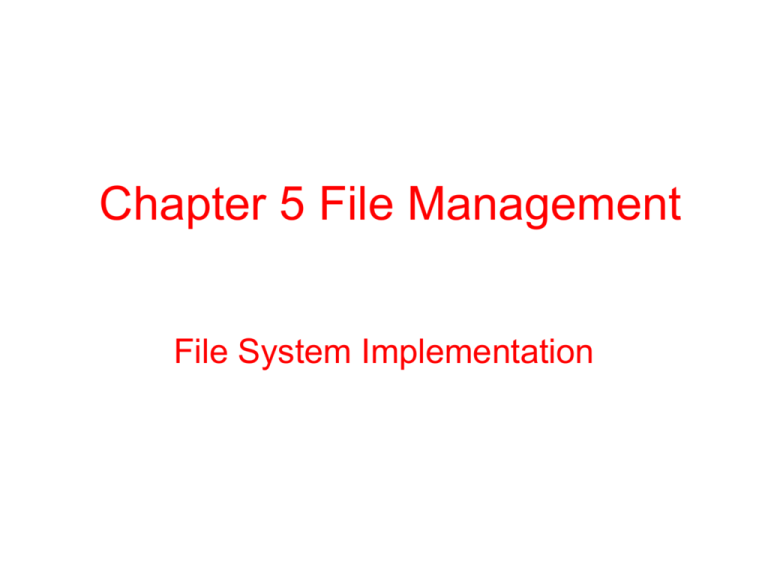
Chapter 5 File Management
File System Implementation
Filesystems supported
• Traditional: ext2
• Second generation: ext3, ReiserFS, IBM JFS, xfs
• FAT-12, FAT-16, FAT-32, VFAT, NTFS (read-only)
• CD-ROM (ISO 9660)
• UMSDOS (UNIX-like FS on MS-DOS)
• NFS (Network File System)
• SMBFS (Windows share), NCPFS (Novell Netware share)
• /proc (for kernel and process information)
• SHMFS (Shared Memory Filesystem)
What is a filesystem?
• Place to store files and refer to them
• Hierarchical structure through use of directories
• A filesystem can be stored on any block device
– Floppy disk
– Hard disk
– Partition
– RAID, LVM volume
– File (for use with a loop device)
– RAM disk
Implementation of File System
——File System Layout
Figure 4-9. A possible file system layout.
Tanenbaum, Modern Operating Systems 3 e, (c) 2008 Prentice-Hall, Inc. All rights reserved. 0-13-6006639
Implementation of File System
——Implementing Files
Contiguous Allocation
Figure 4-10. (a) Contiguous allocation of disk space for 7 files.
(b) The state of the disk after files D and F have been removed.
Tanenbaum, Modern Operating Systems 3 e, (c) 2008 Prentice-Hall, Inc. All rights reserved. 0-13-6006639
Linked List Allocation
Figure 4-11. Storing a file as a linked list of disk blocks.
Tanenbaum, Modern Operating Systems 3 e, (c) 2008 Prentice-Hall, Inc. All rights reserved. 0-13-6006639
Linked List Allocation Using a Table in Memory
Figure 4-12. Linked list allocation using a file allocation table
in main memory.
Tanenbaum, Modern Operating Systems 3 e, (c) 2008 Prentice-Hall, Inc. All rights reserved. 0-13-6006639
I-nodes
Figure 4-13. An example i-node.
Tanenbaum, Modern Operating Systems 3 e, (c) 2008 Prentice-Hall, Inc. All rights reserved. 0-13-6006639
i-node
A UNIX i-node.
Implementation of File System——
Implementing Directories (1)
Figure 4-14. (a) A simple directory containing fixed-size entries
with the disk addresses and attributes in the directory entry.
(b) A directory in which each entry just refers to an i-node.
Tanenbaum, Modern Operating Systems 3 e, (c) 2008 Prentice-Hall, Inc. All rights reserved. 0-13-6006639
Implementing Directories (2)
Figure 4-15. Two ways of handling long file names in a directory.
(a) In-line. (b) In a heap.
Tanenbaum, Modern Operating Systems 3 e, (c) 2008 Prentice-Hall, Inc. All rights reserved. 0-13-6006639
Shared Files (1)
Figure 4-16. File system containing a shared file.
Tanenbaum, Modern Operating Systems 3 e, (c) 2008 Prentice-Hall, Inc. All rights reserved. 0-13-6006639
Shared Files (2)
Figure 4-17. (a) Situation prior to linking. (b) After the link is
created. (c) After the original owner removes the file.
Tanenbaum, Modern Operating Systems 3 e, (c) 2008 Prentice-Hall, Inc. All rights reserved. 0-13-6006639
The virtual file systems (1)
User Processes
vi, ls, mv, rm, file, strings, cat, touch ...
System Call Interface
open() read() write() close()...
VFS Abstraction Layer
ext2
reiserfs
minix
Buffer Cache
Device Drivers
I/O Request
Hardware
ext3
...
Virtual File Systems (2)
Figure 4-19. A simplified view of the data structures and code
used by the VFS and concrete file system to do a read.
Tanenbaum, Modern Operating Systems 3 e, (c) 2008 Prentice-Hall, Inc. All rights reserved. 0-13-6006639
Filesystems supported
• Traditional: ext2
• Second generation: ext3, ReiserFS, IBM JFS, xfs
• FAT-12, FAT-16, FAT-32, VFAT, NTFS (read-only)
• CD-ROM (ISO 9660)
• UMSDOS (UNIX-like FS on MS-DOS)
• NFS (Network File System)
• SMBFS (Windows share), NCPFS (Novell Netware share)
• /proc (for kernel and process information)
• SHMFS (Shared Memory Filesystem)
Filesystem example: ext2
• Partition divided into blocks of 1024, 2048 or
4096 bytes
– Blocksize depends on size of filesystem and expected
usage
• Blocks can have different usage:
– Superblock
– Index node (inode) block
– Indirect block (double, triple)
– Data block
S
I
I
D
D
S
I
I
ID
D
D
D
Superblock
• First block of filesystem, several copies
(at 8193, 16385, ...)
• Contains general info on filesystem
– Last mounted time/place
– Block size
– Pointers to free inodes
– Pointers to free blocks
– Pointer to root of filesystem
S
I
I
D
D
S
I
I
ID
D
D
D
Inodes
• 128 bytes (8 inodes per 1024
–Byte block )
• Contains information about a file:
owner, group, type, size,
permissions, ctime, atime,
mtime, ...
• Contains pointers to data blocks
• Contains pointers to an indirect
block, a double indirect block,
and a triple indirect block
S
I
I
D
D
S
I
I
ID
Owner / Group
File Type
File Size
File Permissions
Time Stamps:
create time
access time
modification time
Link Counter
Additional Flags:
(ACL, EXT2,_FLAGS)
Pointers to Block Data
D
D
D
Data blocks
• Contain file data
• File may be a directory, in which case the data is the
list of file names and inodes in that directory
• Multiple file names may point to the same inode!
(Or files may have multiple names)
Inode 3694
Data 6417
Name
.
..
xyz
abc
Type: d
Data: 6417
Size: 1024
User: 0
Group: 0
Inode 8391
Type: f
Data: 9041
Size: 21
User: 0
Group: 0
Link: 2
Inode
2317
3694
8391
8391
Directory
S
I
I
D
D
Data 9041
File data
xyz
Regular File
S
I
I
ID
D
D
D
Ext2fs summary
• The most important components of a
filesystem are the inodes and the data
blocks
• The filesystem is full if:
– No more inodes are available
– No more data blocks are available
• So tune your filesystem according to the
number of bytes per file:
– Blocksize (1024, 2048, or 4096
possible)
– Bytes-per-inode (4096 default)
Other filesystem features
Filesystems can have other features that can be useful:
• Access Control Lists (ACL)
– Allow more extended permissions, not just rwxrwxrwx
– Not yet supported by VFS abstraction layer
• Journaling
– Keeps a journal of operations that are going to take
place and operations that were successfully committed
– Should make recovery from a crash faster
– Slight performance decrease
• Extended file attributes
– Examples: immutable, auto compression, undeletable
• Labels
– Allow mounting based on label instead of device name
• Performance optimizations
作业
• P182 9, 11, 19, 20



